Green areas are outdoor spaces that are fully or partially covered by vegetation and are found in both urban and rural environments. They range from parks and gardens to forest masses. They are key elements of the environment, essential for creating a balance between urban development and nature. They can have different uses, such as recreational areas, spaces for ornamentation, protection, recovery or rehabilitation of the environment, among others.
The main types of spaces that constitute green areas include:
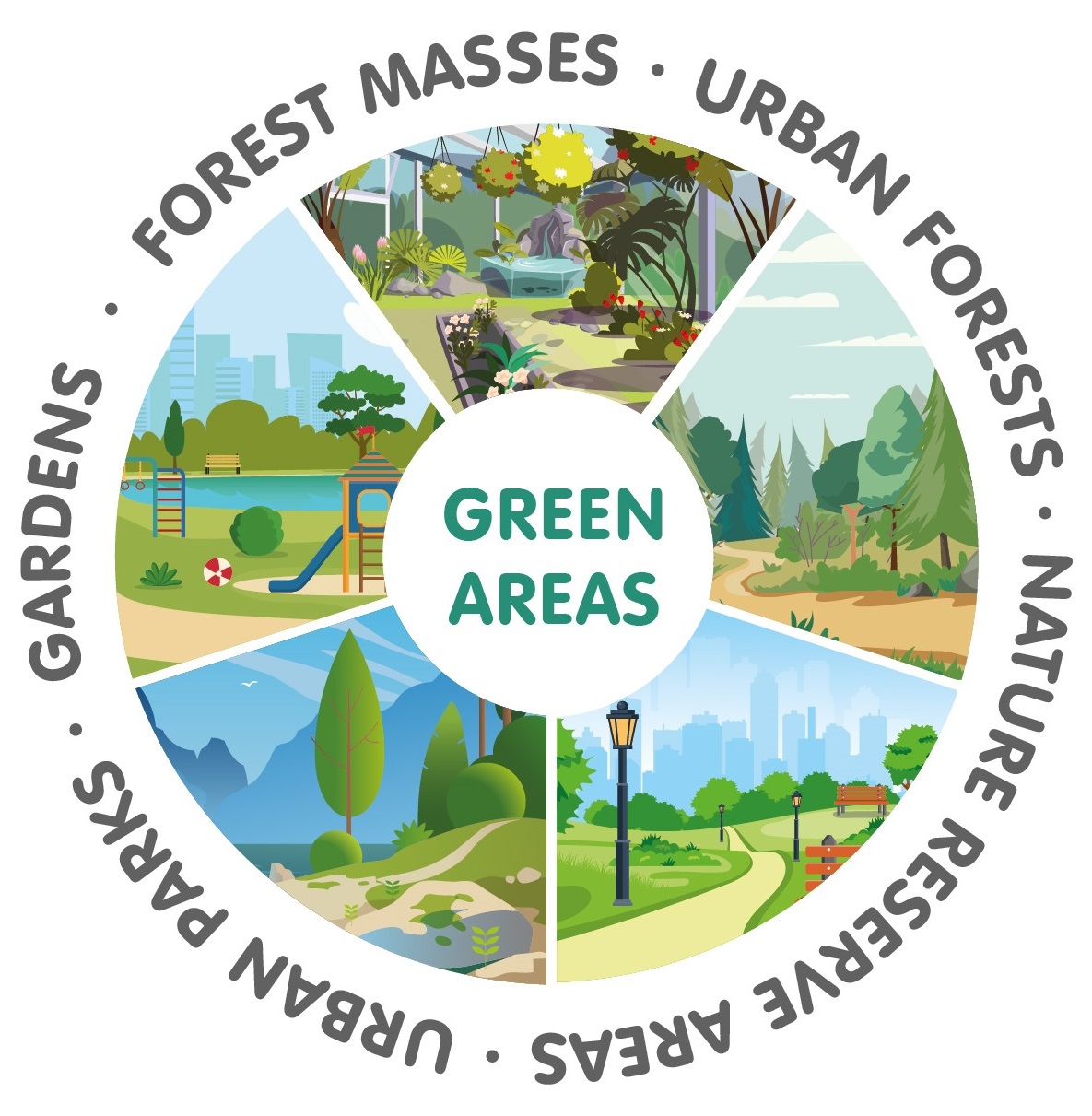
Urban parks: Large spaces designed for recreation, with a combination of grass, trees, gardens, paths, playgrounds and sports areas.
Gardens: Small, ornamental areas that may include flowers, trees, bushes, and landscape elements. They can be public or private and are found in squares, courtyards and residential areas.
Forest masses: areas of land covered by tree vegetation and other plant species, forming a complex, self-sustaining ecosystem. These areas may include natural forests, reforested forests or forest plantations, and may be composed of one or several species of trees, shrubs and herbaceous species.
Urban forests: Wooded areas in or near urban areas that provide shade, clean air and habitat for wildlife.
Nature reserve areas: Protected spaces that preserve natural ecosystems, providing habitat for biodiversity and serving as the lungs of the city.
Urban gardens: spaces within cities dedicated to the cultivation of plants, fruits and vegetables that promote sustainability, conviviality and self-consumption.

They provide spaces for recreation, exercise and rest.

They contribute to improving air quality and reducing pollution.

In urban environments, green areas reduce the temperature.

They provide shelter and food for plants and animals, enhancing biodiversity.

They are valuable resources for environmental education and connecting people with nature.

They help absorb atmospheric CO2 which contributes to reducing climate change
Forest pests and pests affecting parks and gardens can overshadow these benefits. Due to the different ecosystem types of green areas, the predominant plant species and environmental conditions, the pests that occur in each can vary.
GREEN AREA PESTS
Each pest has a particular impact on plants in forests, parks and gardens, and it is essential to identify them properly in order to apply effective biocontrol methods.
Some of the most common pests in these environments are broadly described and organised into families:
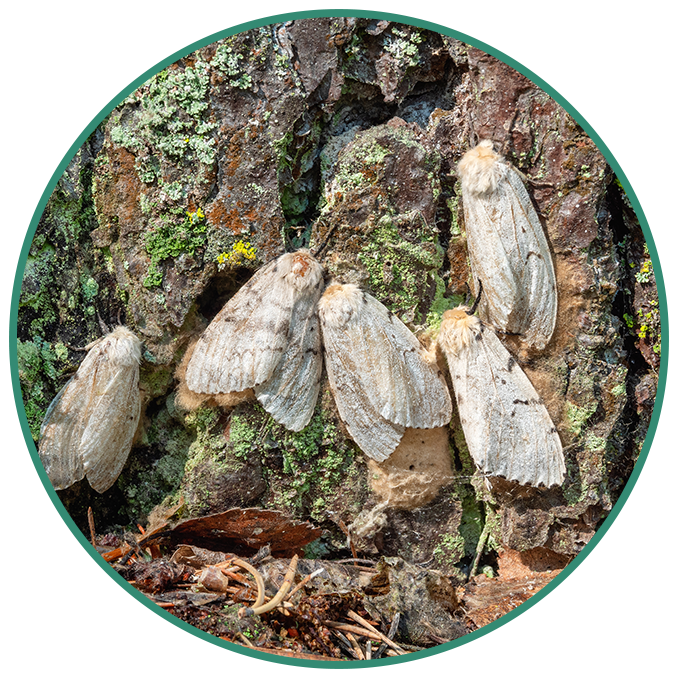
Main species: Cydalima perspectalis , Spodoptera spp., Lymantria dispar, Thaumetopoea pityocampa
Damage: They defoliate plants and trees, leaving them weakened and more susceptible to disease. Caterpillars of some species can damage both flowers and fruit.
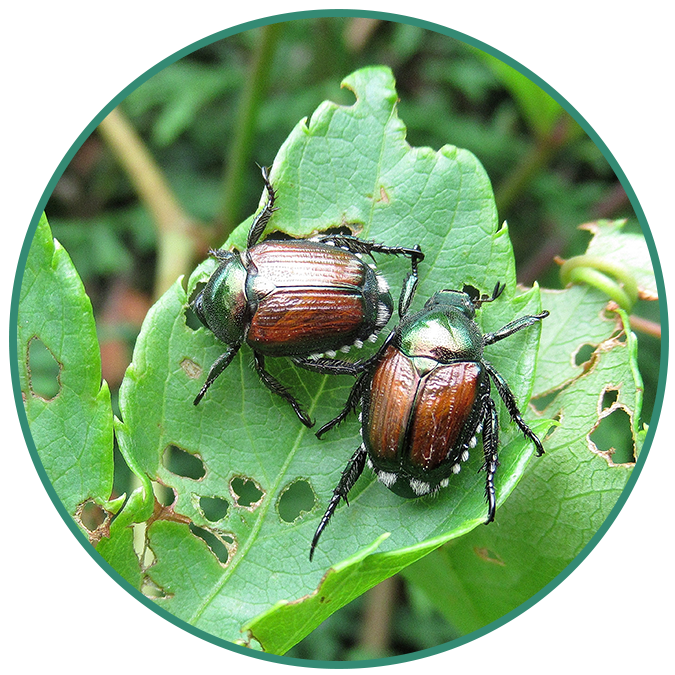
Main species: Popillia japónica, Tomicus spp., Rhynchophorus ferrugineus, Agrilus spp.,Ips spp.
Damage: Larvae feed on roots, trunk and other plant parts, causing weakening and wilting of plants. Adults often consume leaves, causing punctures or partial defoliation.
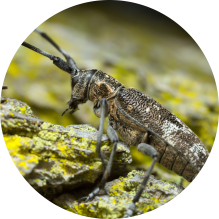
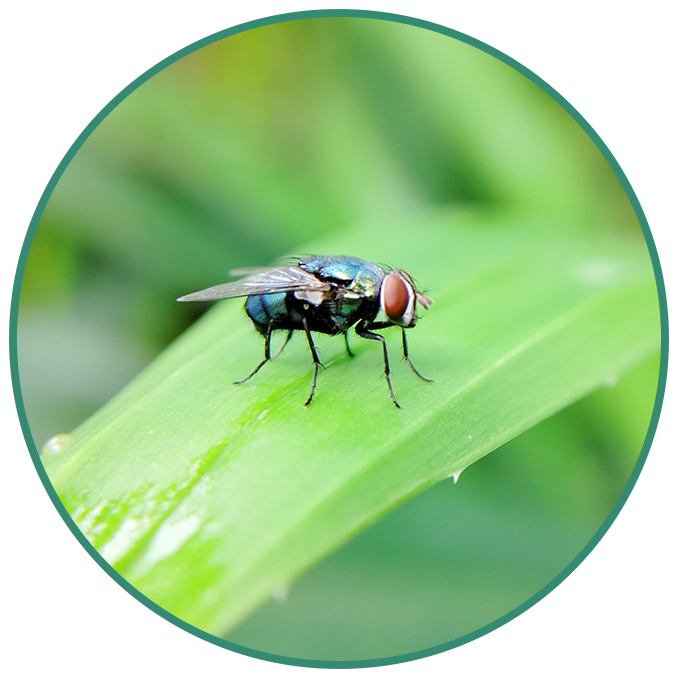
Main species: Musca domestica, Ceratitis capitata...
Damage: Some diptera species cause fruit losses and can also transmit fungi and bacteria to certain plant species. They can be particularly annoying for people and domestic animals.
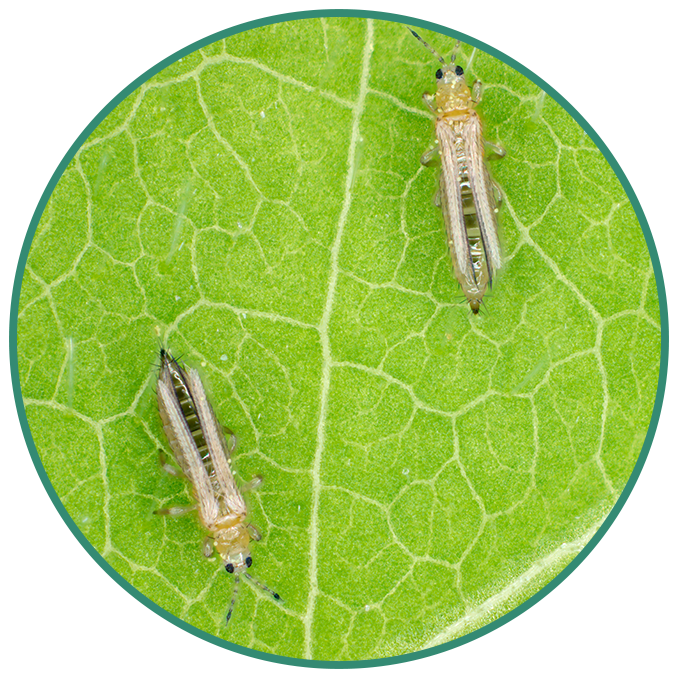
Main species: Thrips spp., Frankliniella occidentalis, etc
Damages: Thrips cause silvery spots and deformation on leaves and flowers by sucking sap. They can also transmit viruses that affect plants.
These pests can cause significant problems in green areas, affecting both plant health and the aesthetics of the environment. Pests can cause anything from foliar and aesthetic damage to the death of entire plants, depending on the species and the extent of the infestation. Affected areas may lose their ornamental value, be aesthetically compromised and require costly control and restoration treatments.
Pests in parks and gardens are more varied and include insects such as aphids, butterfly caterpillars or whiteflies. They often attack more fragile and ornamental plants.

Forest pests include deathwatch beetles and defoliating caterpillars. They can attack large areas of trees and generally cause more severe damages.

Forest pests can occur in gardens and, conversely, typical garden pests can invade forest areas due to several factors. The close proximity of these environments allows for easy transit of insects and other organisms, especially where there are similarities in plant species. Changes in land use, urbanisation and fragmentation of forests create contact areas between gardens and forest areas, allowing pests to move in search of food and shelter. In addition, alterations in environmental conditions may favour the proliferation of pests in both environments, increasing the likelihood of cross-infestations. Finally, the transport of ornamental plants between areas can serve as a vehicle for the spread of pests from one ecosystem to another.
ECONEX SOLUTIONS
In our effort to preserve the health and aesthetics of natural spaces, ECONEX has developed effective and eco-friendly solutions for the care of green areas
ATTRACTANTS AND TRAPS
The use of pheromones and traps allows the attraction and capture of numerous target species for the study or management of different insects present in these green areas. Cydalima perspectalis/ Thaumetopoea pityocampa/ Lymantria dispar/ Orthotomicus erosus/ Rhynchophorus ferrugineus…
At ECONEX, more than 450 types of attractants and repellents are available, along with more than 120 models of insect traps. Some of the most outstanding solutions for use in green areas are:
CROSSTRAP®
La trampa CROSSTRAP® is a state-of-the-art trap for the capture of coleopteran insects during flight. It has been developed in an R&D project (University of Murcia - ECONEX). Its design optimises captures through visual attraction and the use of specific attractant diffusers according to the target pest.
Among the attractants recommended for use in conjunction with the CROSSTRAP® trap, we find:
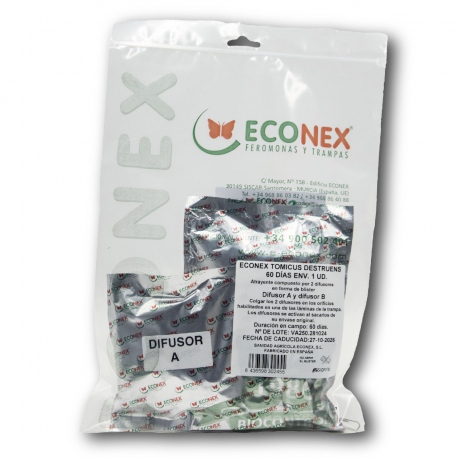
ECONEX TOMICUS DESTRUENS 60 DAYS 1 UNIT.
Diffusers of kairomones to attract males and females of Tomicus destruens with a 60-day duration in the field.
Code: UIPHOVA250
OMDF Registration Number (Spanish Ministry of Agriculture): 150/2013

Más información: www.tomicusdestruens.eu
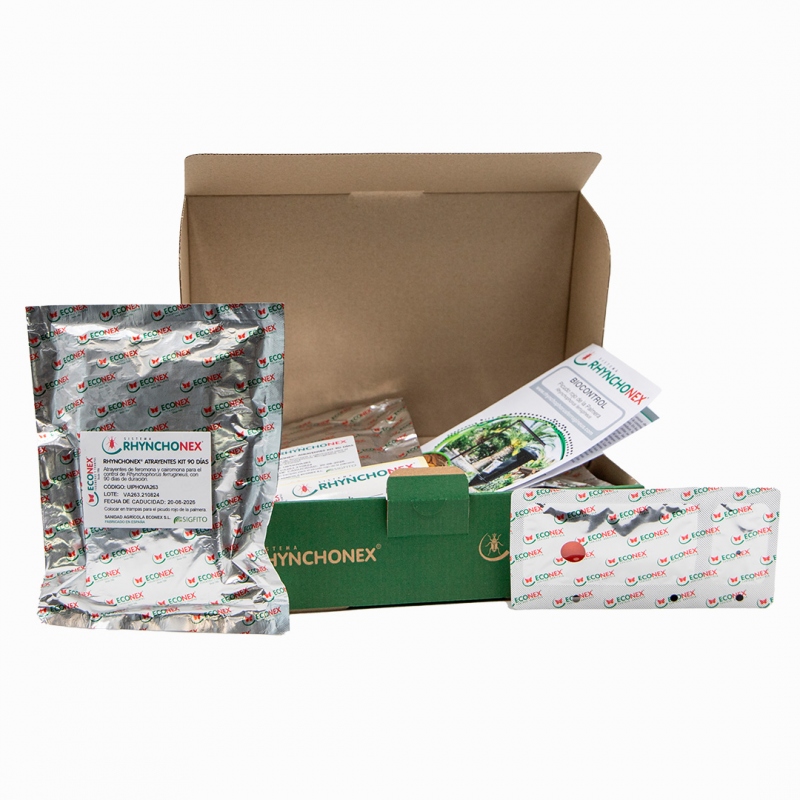
RHYNCHONEX® ATTRACTANTS KIT 90 DAYS
Kit consisting of a blister type diffuser with pheromone and kairomone attractants for the biocontrol of Rhynchophorus ferrugineus. It lasts 90 days in the field.
Code: UIPHOVA263

For further information: www.rhynchophorusferrugineus.eu
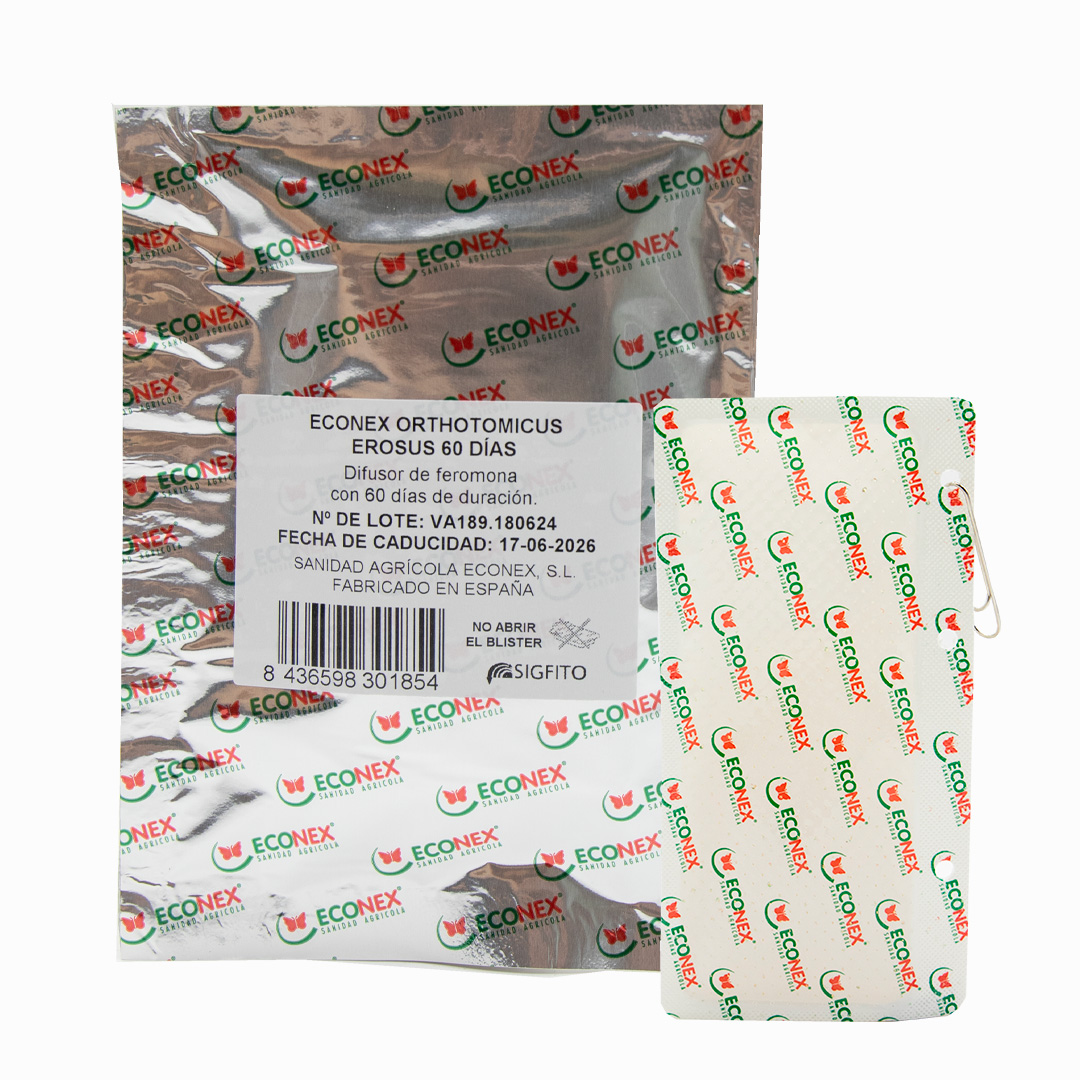
ECONEX ORTHOTOMICUS EROSUS 60 DAYS
Orthotomicus erosus pheromone diffuser for attracting males and females of this species with a 60-day duration in the field.
Code: UIPHOVA189
OMDF Registration Number (Spanish Ministry of Agriculture): 133/2014

Más información: www.orthotomicuserosus.eu
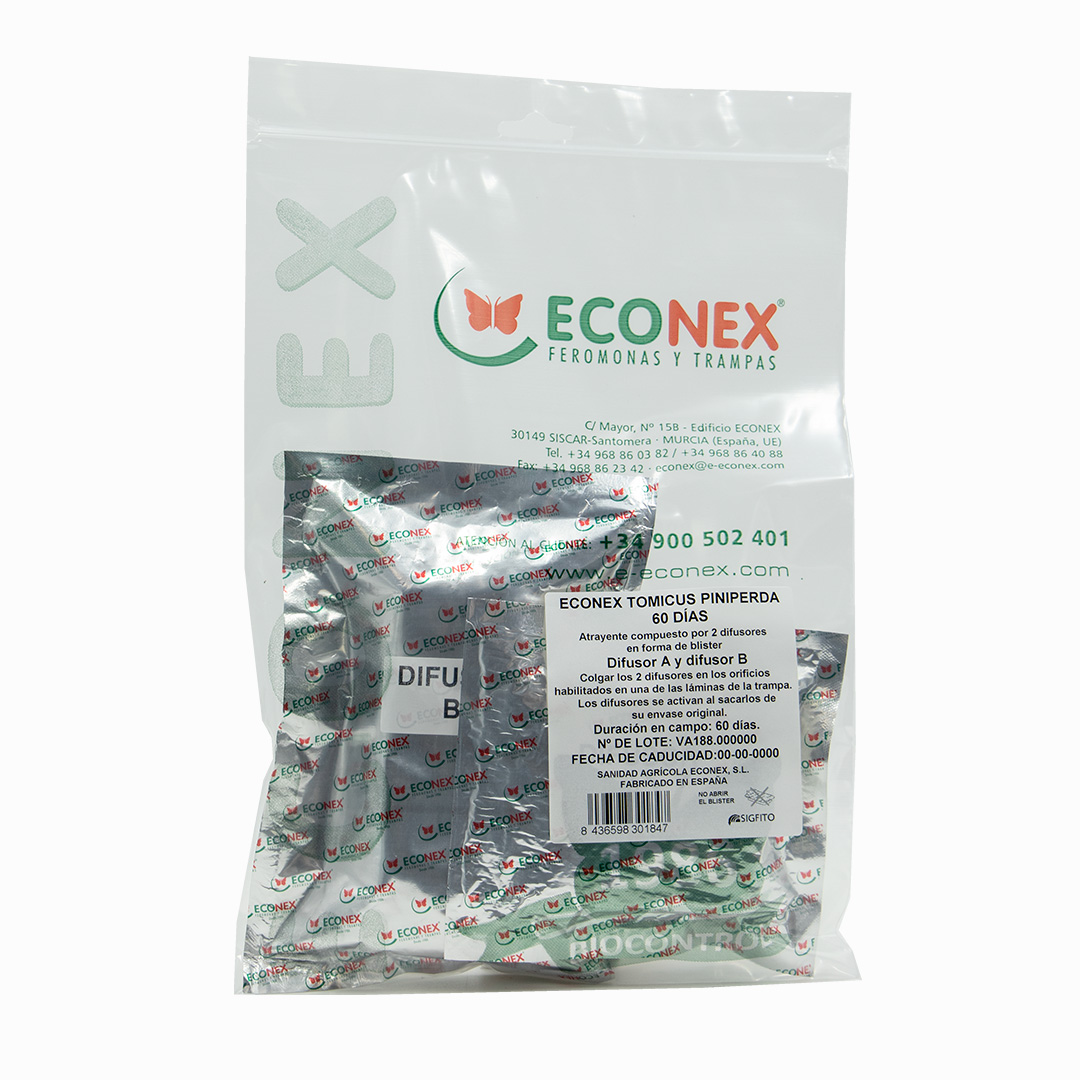
ECONEX TOMICUS PINIPERDA 60 DAYS
Sex pheromone diffuser for the biocontrol of Tomicus piniperda to attract males and females, with a 60-day field duration.
Code: UIPHOVA188
OMDF Registration Number (Spanish Ministry of Agriculture): 149/2013

Further information: www.tomicuspiniperda.eu
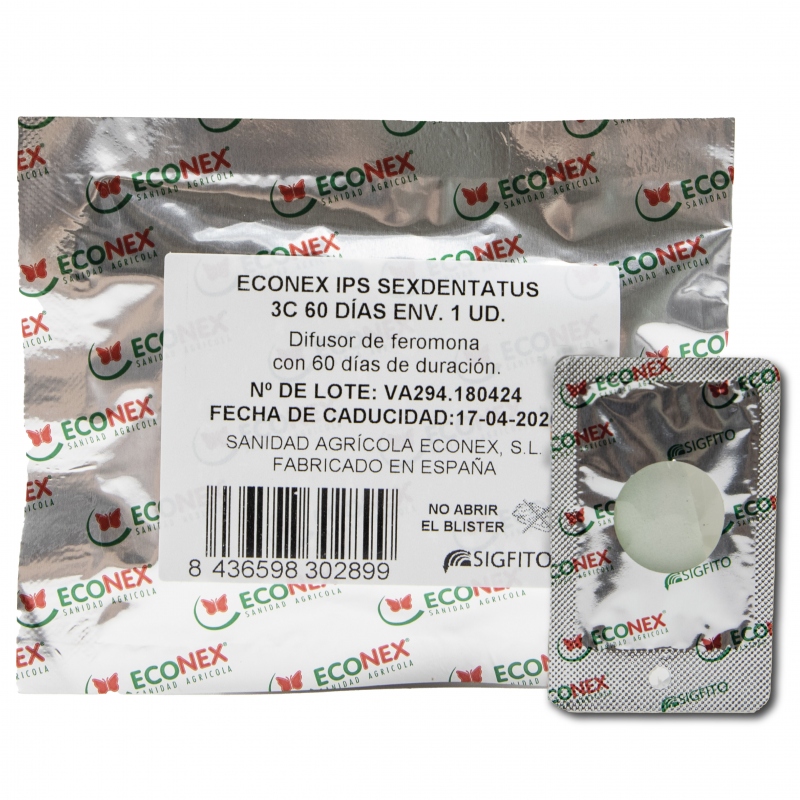
ECONEX IPS SEXDENTATUS 3C 60 DAYS 1 UNIT.
Aggregation pheromone diffusers for the control of males and females of Ips sexdentatus with a field duration of 60 days.
Code: UIPHOVA294
OMDF Registration Number (Spanish Ministry of Agriculture): 135/2014

Further information: www.ipssexdentatus.eu
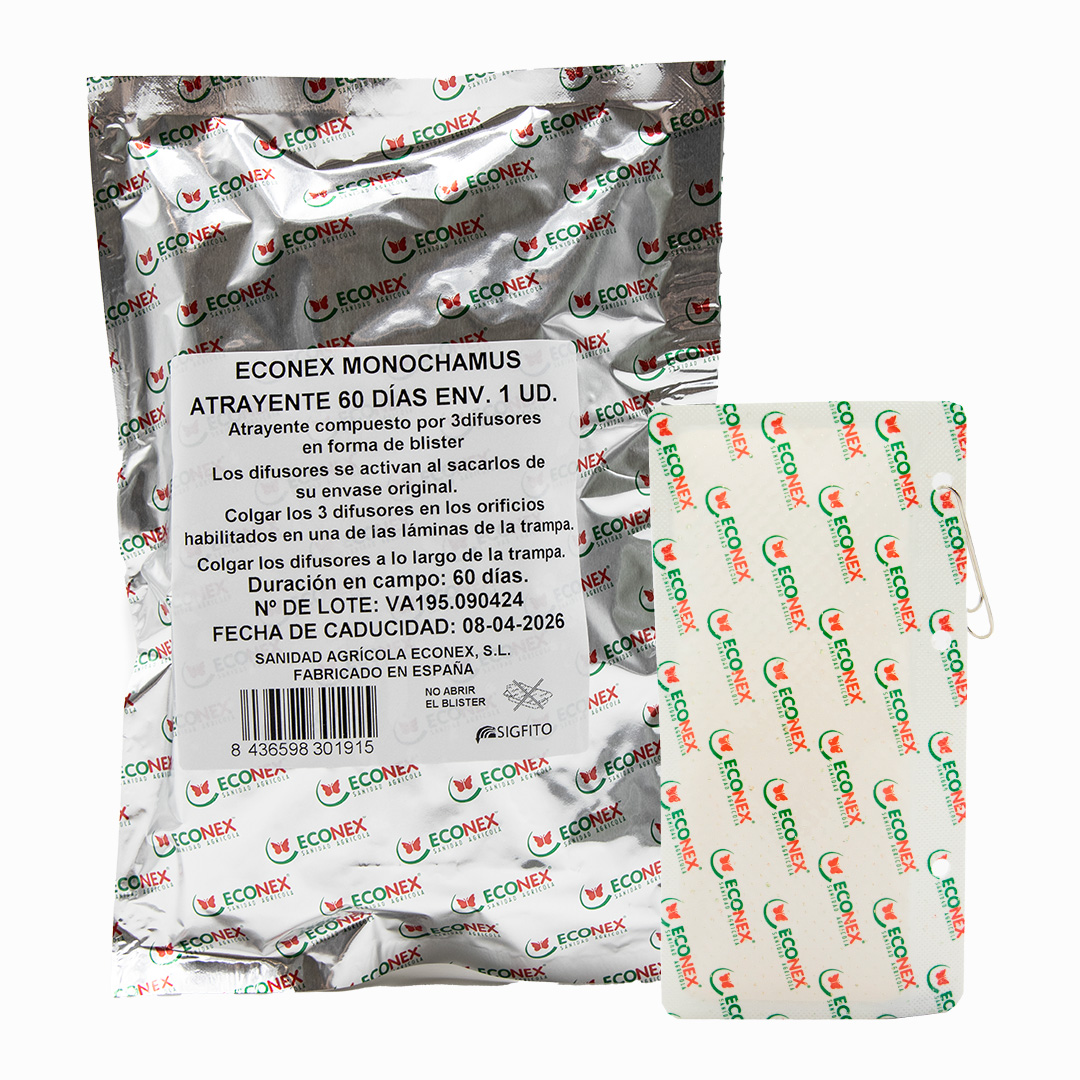
ECONEX MONOCHAMUS ATTRACTANT 60 DAYS 1 UNIT
Diffusers of kairomones for the control of Monochamus galloprovincialis with a 60-day duration in the field.
Code: UIPHOVA195
OMDF Registration Number (Spanish Ministry of Agriculture): 134/2014

Further information: www.monochamusgalloprovincialis.eu
ESCOLITRAP®
This trap is designed to catch xylophagous pests that affect woody crops such as pomegranate, walnut, chestnut, carob, vines, etc.
It consists of two black vanes embedded in a black funnel that directs the catches to a high-capacity collector. At the top is fitted into a green lid with a hanger. The attractants are hung directly from the holes provided for this purpose in the vanes.
This trap is suitable for trapping xylophagous pests such as Apate monachus, ragweed scolytids (Xyleborini) affecting chestnut trees and vines, as well as for detecting invasive species or any other species caught with the trap CROSSTRAP® MINI in locations where discretion of the trap must be prioritised due to public use or risk of damage by vandalism.
Recommended attractants for use with the ESCOLITRAP® include:
PROCESSIONARYTRAPNEX® L
TCollar trap designed to capture processionary pine caterpillars, Thaumetopoea pityocampa, as they descend the trunk of trees where they have formed pockets. It takes advantage of the aggregate and social behaviour of this species to capture the whole group of larvae when they go to the ground to bury and pupate.
Advantages:
ECONEX TRAP G
This trap is suitable for the capture of adult males of the pine processionary (Thaumetopoea pityocampa) and other species such as the (Lymantria dispar).
The insects are attracted to the trap by the specific attractant for the target pest. They enter the trap through the upper openings. Once inside, the conical design and the funnel make it difficult for them to escape and they are trapped.
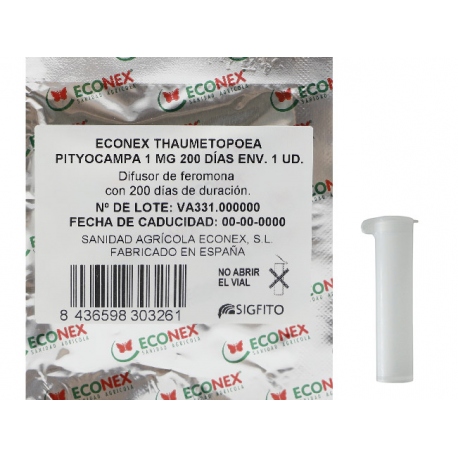
ECONEX THAUMETOPOEA PITYOCAMPA 1 MG 200 DAYS 1 UNIT.
Sex pheromone diffuser for biocontrol of Thaumetopoea pityocampa to attract males, with a 200-day field duration.
Code: UIPHOVA331
OMDF Registration Number (Spanish Ministry of Agriculture): 112/2016

Further information: www.thaumetopoeapityocampa.eu
ECONEX CERAMBYX 1L AND ECONEX CERAMBYX 5L
Cerambyx is a type of coleopteran that affects hardwood species of the genera Fagus, Castanea y Ulmus, although they are much more frequent on any species of Quercus. Occasionally, it has also been reported on any species of Quercus. Occasionally, it has also been reported on Corylus y Ceratonia.
With the liquid attractant ECONEX CERAMBYX 1 L both males and females of this species are attracted. Being a liquid attractant for filling traps, the duration in the field will depend on the environmental conditions of humidity, temperature, exposure to the sun, etc It is used to prime ECONEX DISPOSABLE CERAMBYX TRAP.
ECONEX CERAMBYX 60 DAYS AND ECONEX CERAMBYX HIGH RATE RELEASE 30 DAYS
Kairomone diffuser for the attraction of both sexes of different species of Cerambyx genus.
The diffusers are presented in blister form, with a field duration of 60 and 30 days respectively. They are individually packaged in an aluminium envelope with a specification label. Once removed from the package, the diffuser does not require any activation operation, nor does it need to be opened, just properly placed in the trap.
It is recommended to use the CROSSTRAP® XYLOFAGOS WITH DRY COLLECTION CUP, specially designed for the capture of insects that walk on the bark of trees.
The formulation of these attractants is patented by the UNIVERSITY OF HUELVA and is exclusively managed by SANIDAD AGRÍCOLA ECONEX, S.L.
For further information about Cerambyx and ECONEX solutions, please visit our specific website: www.cerambyx.eu
FAMILY CHROMATIC TRAPS
Chromatic traps, in sheets or rolls, are sticky traps consisting of a light-resistant polyethylene film. They are mainly used for catching thrips. In general, blue chromatic traps are set for detection and monitoring with a density of 2 to 4 traps.
The film is coated on both sides with a solvent-free pressure-sensitive adhesive, which is protected by a translucent siliconized paper sheet. A margin of 1 cm is left free of impregnation, following the longer side on both sides of the film, to facilitate handling. They have holes in the corners for easy installation.
The chromatic rolls are activated when unfolded, and will be active 24 hours a day for a duration of 6 to 8 weeks, or until completely saturated with insects. The rolls are designed with a light-resistant polyethylene film coated on both sides with a pressure-sensitive, solvent-free adhesive.
For further information about the CHROMATIC TRAPS, please visit our specific website: www.chromatictraps.com
SPECIAL ATTRACTANTS
Using these attractants does not affect beneficial insects, such as bees, and they are completely harmless to humans and animals.
ECONEX FLY-CATCHER
Ecological kit traps optimised to catch domestic flies and other species of flies. They are designed to be placed in outdoor spaces such as gardens, terraces, parks or outdoor areas with pets, among others. Composed of a disposable container and a bait that is packaged in water-soluble bags of 20 grams to dilute each 2 of them in 1 litre of water.
For further information about Musca doméstica and ECONEX solutions please visit our dedicated website: www.muscadomestica.eu
ECONEX FLY AND WASP ATTRACTANT
Natural liquid attractant developed to attract flies and wasps with a field duration of 60 days. It is used in combination with the ECONEX MOSQUERO trap to attract flies and wasps to it, where they die by drowning.
VELUTINATRAP® ATTRACTANT 190 ML
Natural liquid attractant for the Asian wasp Vespa velutina, with a 60-day field duration. It is used together with the VELUTINATRAP® specially designed for the capture of the Asian wasp Vespa velutina. It is a large capacity trap, highly resistant to the elements and has a long duration in the field.
Furthermore, we also have a kit consisting of 2 VELUTINATRAP® traps and 2 bottles of VELUTINATRAP® ATTRACTANT 190 ML
For more information on Vespa velutina and ECONEX solutions please visit our dedicated website: www.vespavelutina.net
ECONEX THRIPS SPP ATTRACTANT
Both sexes of the Thysanoptera order are drawn to the attractant diffuser ECONEX THRIPS SPP ATTRACTANT 30 DAYS Thrips are small insects that cause direct and indirect damage to a wide variety of plants in the course of feeding. They can affect horticultural, fruit and ornamental crops, both outdoors and in greenhouses.
For more information on Vespa velutina and ECONEX solutions please visit our dedicated website: www.thysanoptera.es
AUXILIARY PRODUCTS
Our tools help to protect crops and improve the health of these natural spaces.
NESTING AND INSECT SHELTER FAMILY
Conditioning the habitat to favour biodiversity and the presence of natural allies is one of them. Birds, bats, hedgehogs and some insects are natural allies as they feed on harmful insects as part of their diet. This contributes to increasing species diversity and helps to control unwanted insect and pest populations.
ECOBIRDNEX®
If your enemies are not insects but the excessive presence of birds or rabbits, whose feeding on the tender leaves of lettuce or even digging up the seedlings can cause significant damage, affecting the growth and production of the plant, we count on ECOBIRDNEX®.
An ecological vibrating tape with acoustic and optical effects that provides really effective protection. It vibrates even in the lightest breeze, producing light buzzing and constantly changing movements that birds can't stand.
Its main advantages are:
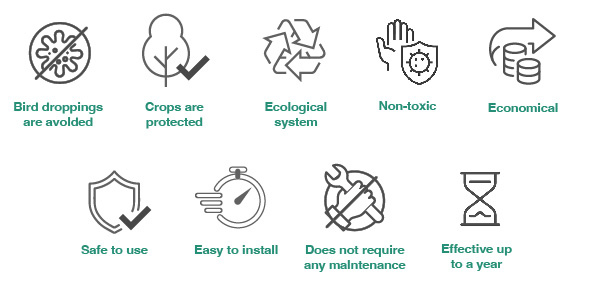
For further information about ECOBIRDNEX® please visit our specific website: www.ecobirdnex.eu
ECONEX GREEN AREAS LEAFLET
Leaflet in PDF format that can be downloaded by clicking on the image.
ECONEX KNOWLEDGE CENTRE
ECONEX offers you the first open knowledge centre that brings together everything you need to implement pest biocontrol in your crops. We have developed different types of resources to share with you the knowledge we have acquired during our more than 38 years of experience. Each of them is designed to answer, in the best possible way, different questions related to pheromones, attractants, repellents and insect traps.
To access the ECONEX KNOWLEDGE CENTRE click on the image.
SANIDAD AGRÍCOLA ECONEX, S.L. only guarantees the composition, formulation and content of the products, taking responsibility for the direct, immediate and exclusive damages caused in the composition, formulation and content of the products sold. SANIDAD AGRÍCOLA ECONEX, S.L. will not be held responsible for damages produced by factors beyond the company’s control that have either totally or partially contributed. For instance, the weather conditions, usage or mixing with other products, amongst others. In addition, SANIDAD AGRÍCOLA ECONEX, S.L. will provide recommendations and information supported by extensive and meticulous research and tests; which must be taken into account by the customer when using the products. The customer will be responsible for any damage caused, in whole or in part, for the total or partial non-observance of the instructions provided. Furthermore, the customer will be responsible for all that is referred to as the performance of the products; which comes from total or partial non-observance of the instructions and information provided by the company.